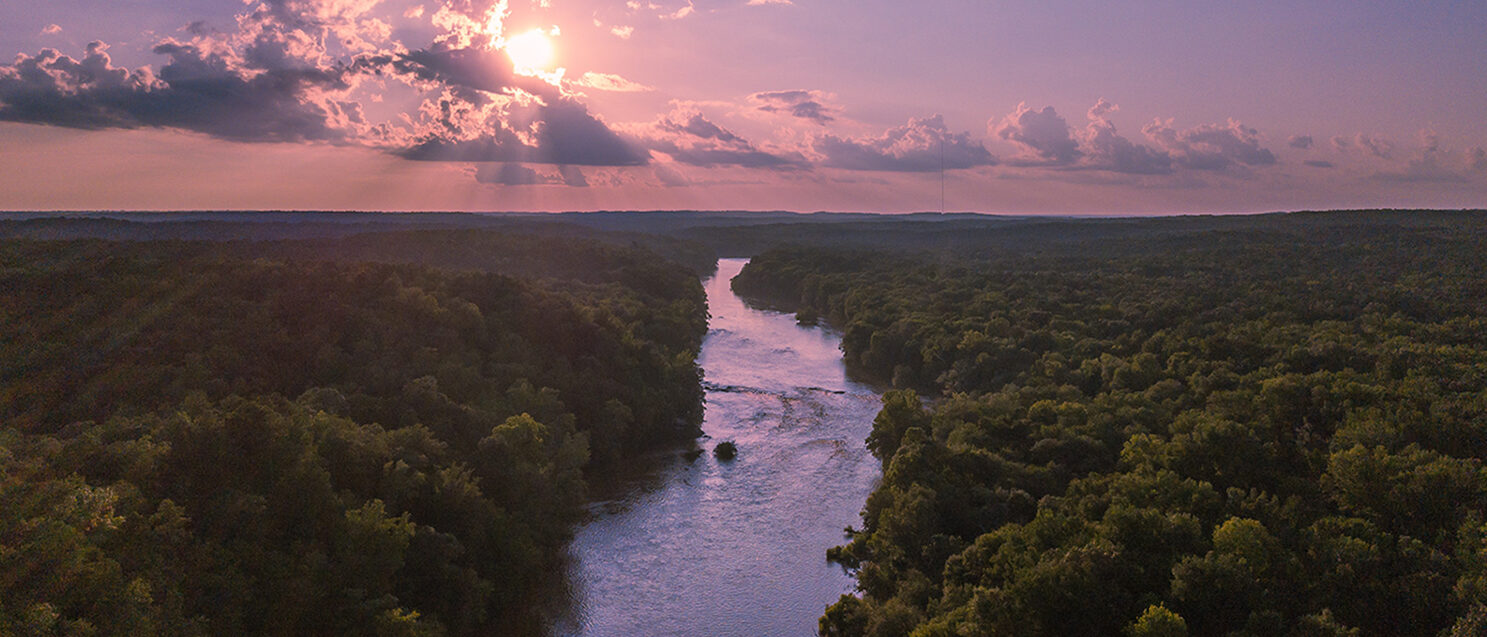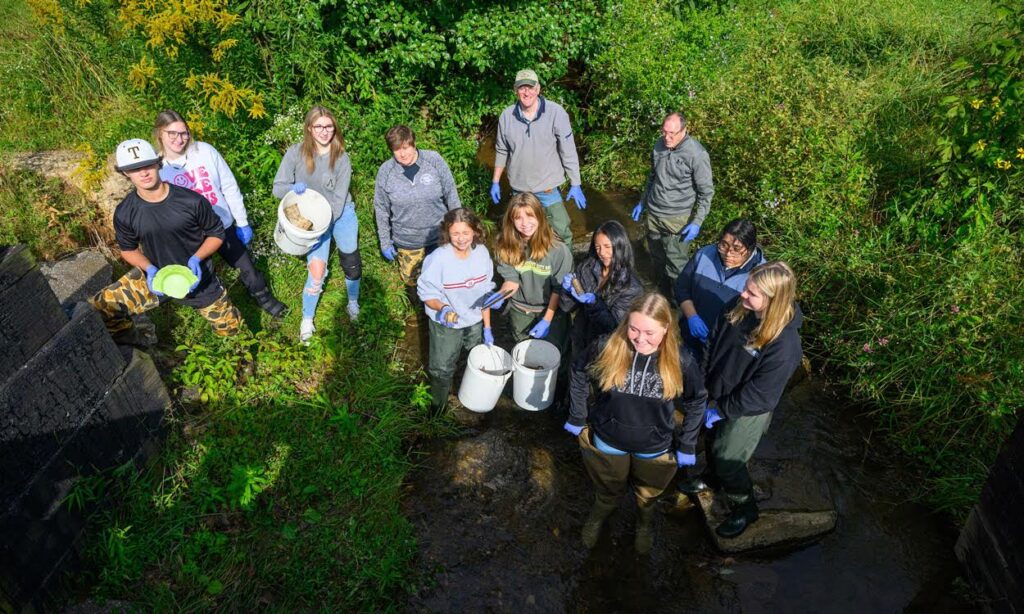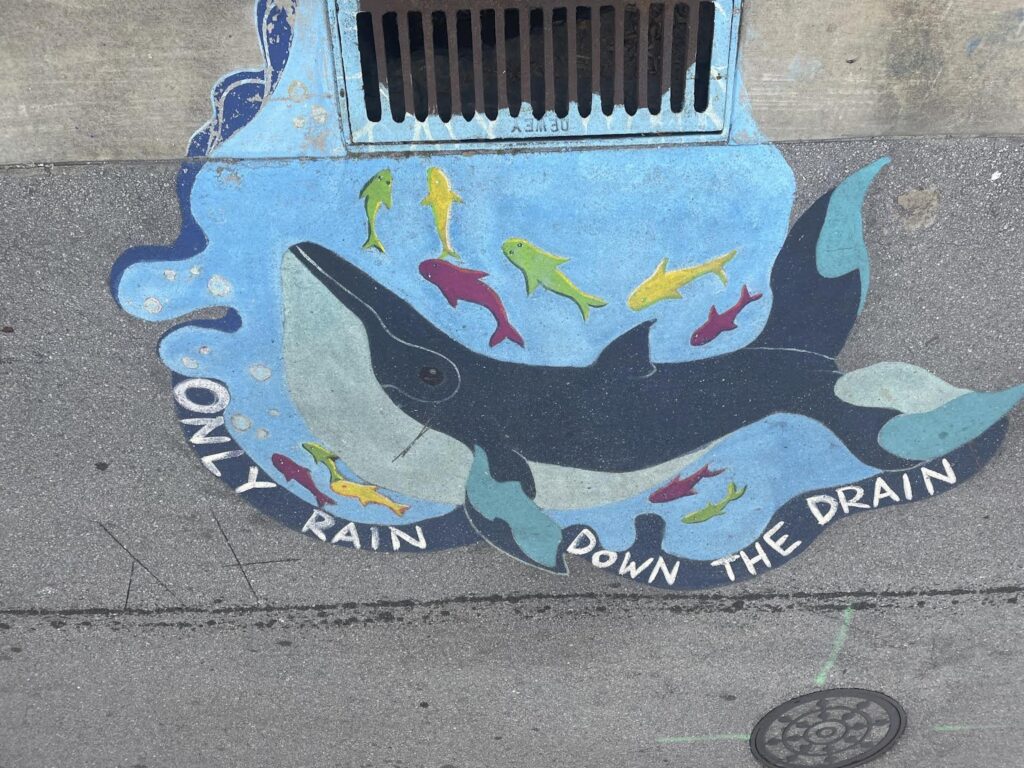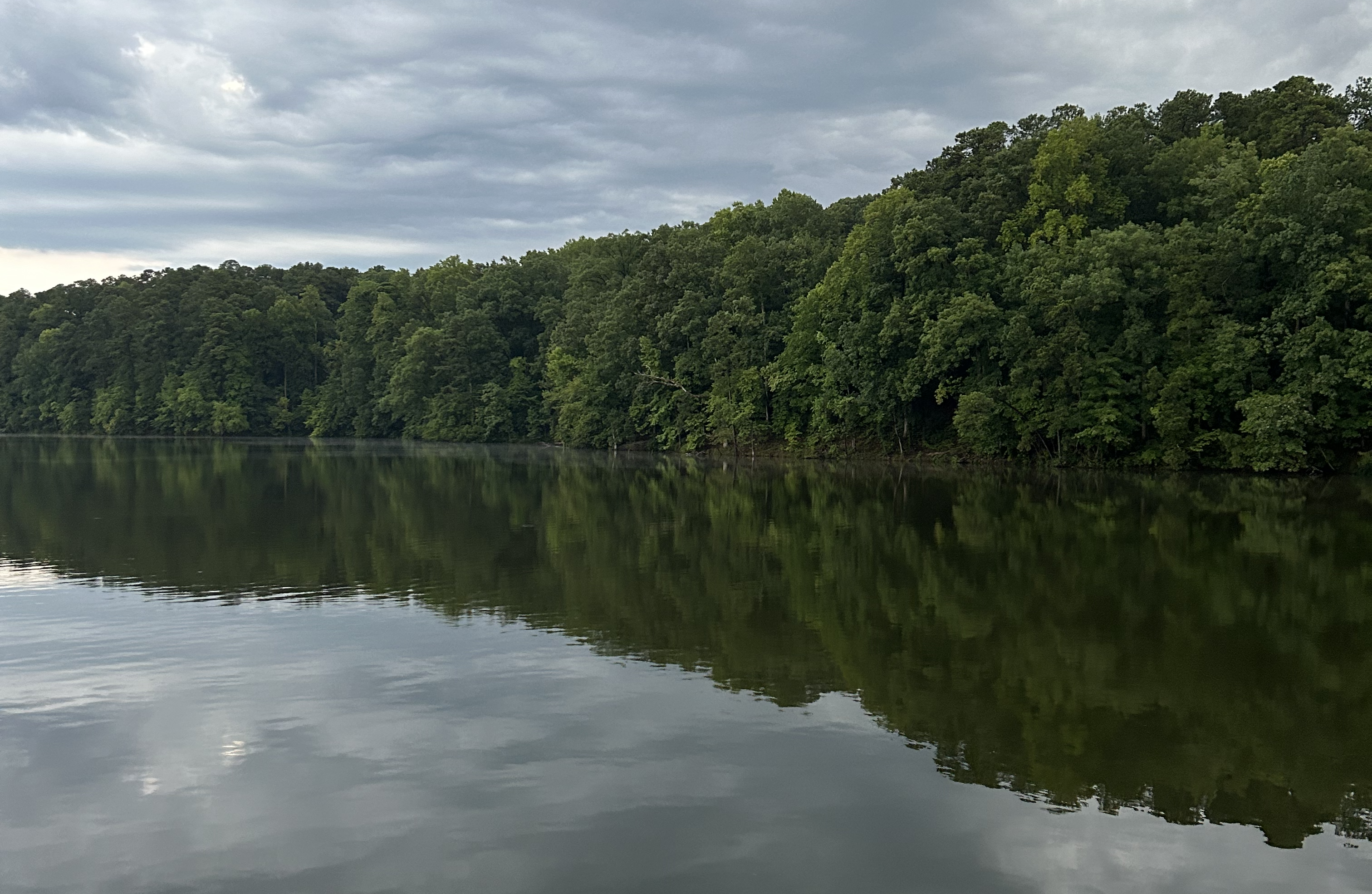From the Mountains to the Sea: Researchers and Community Activists Focus on Plastic Pollution in North Carolina

From plastic trash littering our creeks and rivers, to microplastics in our waterways and bloodstreams, plastic pollution can feel ubiquitous and inevitable—but some North Carolina researchers are doing vital work to measure plastic in our environments, raise awareness about its impacts, and combat its effects.
Jerry Miller is measuring the microplastics in headwater basins in the Appalachian mountains of western North Carolina. Until now, little research has been done to measure exactly how microplastics enter waterways—especially not when it comes to headwater basins at the source of freshwater streams. While previous research has focused largely on major rivers, the ocean, and the downstream effects of pollution, Miller is studying freshwater streams at their source.
A professor of Environmental Science in the Department of Geosciences and Natural Resources at Western Carolina University, Miller’s research focuses on water quality and pollution in riparian ecosystems. For his Community Collaborative Research Grant (CCRG) project, funded by the North Carolina Water Resources Research Institute (WRRI), North Carolina Sea Grant, and the Kenan Institute for Engineering, Technology, and Science (KIETS), he has teamed up with Jason Love, Associate Director at the Highlands Biological Station, to track microplastic sources and quantities at seven sites along Richland Creek, a headwater basin near Waynesville, North Carolina.
Spearheaded by Miller and Love, the project also involves collaborator Austin Gray, an assistant professor of Biological Sciences at Virginia Tech, as well as graduate and undergraduate students from Western Carolina University and Virginia Tech, collaborators from the local community via Haywood Waterways Association, and high school students from Tuscola High School.
Breaking new ground on the study of microplastics in freshwater ecosystems
There’s a lack of data about microplastics in river waters, but Miller and Love’s research is the first step in the right direction toward building a foundation of knowledge about how these tiny particles move through our waterways and affect water quality and organisms therein.
“Plastic contamination in marine coastal environments has been studied since the 70s,” says Miller, but the same isn’t true of freshwater ecosystems, where studies began in earnest only in the 2010s.
In addition to collecting valuable scientific data, Miller and Love’s team is also on the frontlines of developing systems and processes that work for this type of environment. “We’ve kind of had to develop the methods ourselves,” says Miller.
Microplastics are durable and persistent, and typically less dense than other river sediment. This means that they don’t behave in the same way that other river sediment does, and models that describe the movement of sediment like gravel or organic matter fail to capture the unique ways that microplastics move in these streams.
“Microplastics are not uniformly distributed within the water column. And so that’s raised some issues in terms of how to get a representative sample at any given moment in time,” explains Miller. “Of course, we’re starting to work that out. But it’s been a bit of a challenge.”

Collaborating with students to collect trash and analyzing the sources of plastic pollution
Macroplastic debris and microplastics are surprisingly abundant even in remote places like the area around Richland Creek. “It was surprising to see how much trash there was,” says Love. “We found over 900 pieces of trash, more than one piece of trash per square meter.
The team worked with over 80 students from Tuscola High School as well as volunteers from the Haywood Waterways Association to collect the trash. “The high school students really got into it,” says Miller. “They were excited about getting out there. They were amazed at how much stuff they got and what they got.”
But one unique finding of Miller’s research is that much of the microplastic content present in headwater basins like Richland Creek may come not from the breakdown of larger plastics littering the environment, but from atmospheric microplastic deposits that are flushed into streams and rivers when it rains.
“It’s kind of assumed that these larger plastic pieces of debris decomposed into the small microplastics,” explains Miller, but the lack of development near Richland Creek, coupled with the similarities between samples collected from the atmosphere and water in the area, point toward atmospheric deposition as a key driver of microplastic pollution in the area. “I think one of the main things we found is that the concentrations of microplastics are particularly high,” says Miller. “We think atmospheric sources are a primary component. We knew it was a potential source, but it surprised us that it was such a significant source.”
Another surprising finding from this study: more than 85% of microplastics in rivers were fibers, mostly from clothing, carpet, and geotextiles. “We think a lot of it’s coming from the textiles like clothing, sleeping bags, tents, all the kind of stuff that gets dumped,” says Miller. But it’s not necessarily from local littering: “You have 8 billion people on the planet and most of us wear clothes. That kind of adds up,” says Miller. “It’s probably not local.”
The bottom of the food chain: microplastics in caddisflies
Microplastics aren’t just present in the water itself—they’re also present in the living organisms who make their home in the environment. In addition to measuring and analyzing microplastics in the stream itself, Miller and Love’s team is also studying how the larvae of caddisflies, a type of small insect, are affected when exposed to microplastics. The Southern Appalachians are a hotspot of biodiversity, and, due to their ubiquitous presence at the bottom of the food chain, these small insects play an essential role in food webs.
The research aims to study if exposure to microplastics affects caddisflies’ abilities to filter algae. “We found microplastics in both the caddisflies and their nets,” says Love. The next step is to analyze not only the type and quantity of microplastic contamination present, but also its effects. “You know, someone will say, Well, so what, they’re in there, but what are they doing?” says Miller. “And that’s kind of the next question, right? What the impacts are.”
Ways to get involved
Miller and Love have partnered with Haywood Waterways Association to engage local communities in helping to collect trash and assist with their research. Local residents interested in getting involved in the project should keep a look out for calls for volunteers on the Haywood Waterways website and in The Mountaineer. The team also works with organizations including Mainspring Conservation Trust and MountainTrue to connect with volunteers and members of the community.
As for the bigger picture, their analysis of microplastics may give legislators food for thought. “I’m not involved with the policy aspect of it,” says Miller, “but I think some of the data we’re collecting with the large pieces of plastic trash have implications for plastic use that can be used by policymakers and others.”
As for Miller and Love, their research will continue through 2025 thanks to another WRRI-USGS funded grant.
Combating plastic pollution in coastal North Carolina
Zoom out a little, trickle down through creeks and streams through western North Carolina’s mountains, across the piedmont, down toward the crashing waters of the coast. Miles away from mountain streams and caddisflies, Dr. Liz DeMattia, lead Research Scientist for the Duke University Marine Lab Community Science Initiative, and Lisa Rider, Executive Director of the Coastal Carolina Riverwatch, are approaching plastic pollution from another angle.
Their CCRG project is focused on raising awareness about the impact of plastic in the environment and engaging local students and community members in environmental stewardship.
A scientist at Duke University Marine Lab, DeMattia has 27 years of experience with environmental community engagement, including creating environmental literacy programs, developing community workshops, and delivering environmental education. Rider is an expert in marine debris, recycling, and working with local stakeholders to maintain clean waterways. She runs the NC Marine Debris symposium and was integral in the creation of the NC Marine Debris reduction plan.
This collaboration between Duke University Marine Lab and Coastal Carolina Riverwatch aims to educate students and community members about the challenges of polluted stormwater in coastal ecosystems while fostering environmental literacy in the next generation of researchers and activists. The project involves students from all levels, from high schoolers to graduate students, and facilitates multiple community events and storm drain art installations.

Connecting students, community members, and scientists through art
One of the main components of the project is a series of community art events centered around the Adopt-A-Drain program, which encourages students and community members to take ownership of individual storm drains. When runoff enters storm drains, it often carries with it pollutants like trash and macroplastics. Featuring the slogan “Only Rain Down the Drain,” the decorated drains help to raise awareness about the environmental impact of litter and plastics.
Rider and DeMattia view this fusion of science and art as an effective way to convey scientific information to those who may not be scientists themselves. “I think the thing that really benefited this project the most was the art part of it, the visualization of the information,” explains Rider. “It’s not just data collection. It’s not just medicine, science. It’s not just an art project, but all of those things combined.”
After learning about plastic pollution, students from East Carteret High School, led by art teacher Michael Rhinehardt, participated in a community event to decorate storm drains. “I was really amazed by the student art,” says DeMattia.
“The students were really into it,” says Rider. “They did a great job. And what’s really cool about this is now the students have ownership of this project. They have ownership of this drain because that’s the drain they put their mark on it. Their families know about this drain. The community knows about the drain. The mayor of Beaufort was involved and was there and helped with the drain painting. And so now there’s this community ownership.”
The project aims to involve not only students but also members of the community who are affected by pollution in their environment to take steps to decrease the plastic present in stormwater and advocate for clean water in the community. “Plastic pollution is one of the top five concerns amongst folks who fish at the coast as it relates to water quality, and stormwater is also within that top five,” says Rider.
Building momentum for future projects
Not only was the community interested in and excited by the event, but Rider and DeMattia’s project also received praise from local government officials, establishing a foundation on which future events can build. “Community collaboration takes time,” acknowledges DeMattia, but building relationships with stakeholders in the community can pay enormous dividends.
“Now the momentum is there,” says Rider. “I heard a quote from the mayor at one of the last events that we did where she said ‘These are so wonderful, I really want these drains painted everywhere, I want all of the drains in Beaufort painted like this.’”
“The whole is more than the sum of its parts when it comes to community collaboration,” emphasizes DeMattia. With engagement from high school students, community members and elected officials, undergraduate students, graduate researchers, and more, the project transcends traditional academic boundaries to involve community members at every level.
There’s also the potential to expand to other towns and municipalities in the area. “We’re hearing from other communities saying ‘Hey, I want to do that too.’” says Rider.

Ways to get involved
While the events themselves have passed, there’s still plenty of opportunities for North Carolina residents to get involved, says Rider. “No matter where you live, in coastal North Carolina or throughout the state, you can participate in this.”
There’s an Adopt-A-Drain app that allows residents all over the state and beyond to take notes on their own local drains and drainage systems, including not just sewer drains but also ditches, swales, and culverts. ECHS Environmental Club and Carteret County Community Environmental Club students will conduct research using data collected by the app in order to better understand how foot traffic affects plastic pollution in stormwater.
As for the drain art, Rider and DeMattia emphasize that it’s a project that can be easily implemented in other communities. “All your community needs is an artist or an art teacher. You need some supplies and you need permission from the municipality that’s responsible for the drain. That’s really all you need,” says Rider.
The benefits of community collaboration and CCRG funding
Both projects received funding from the Community Collaborative Research Grant (CCRG) program, supported by WRRI, Sea Grant, and KIETS, which is designed to facilitate collaborative research between scientific experts and members of the community. Projects are headed by a scientific lead as well as a local knowledge expert, using a combined approach to water-related research and education with local expertise.
Miller, Love, Rider, and DeMattia all emphasized the unique nature of CCRG-funded projects, which make it possible to involve members of the community at every level. “I think one of the real strengths of CCRG projects is that they tend to be so collaborative. They’re always greater than the sum of their parts,” says Miller.
In addition to involving students ranging from high school students to graduate students, Rider and DeMattia’s project also builds on the collaborative nature of local organizations and institutions with overlapping missions. “This is a really cool collaborative effort with North Carolina Sea Grant and WRRI, three different coastal marine science universities, and a local water quality nonprofit, coming together and combining resources with local high schools, town government, and other folks to really make it successful. It’s definitely not the type of project or program that can be done by just one of those,” says Rider.



